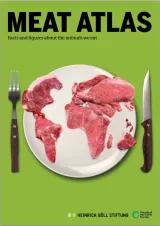Meat Atlas - Facts and figures about the animals we eat
Food is a necessity. And it’s very personal. Satisfaction reflects ethical decisions, and private concerns can be very political in nature. We are more and more alienated from what is on our plates and in our hands, so responsible food consumption is something that an increasing number of people demand. These people need information on which to base their decisions and to answer their questions.
This publication sheds light on the impacts of meat and dairy production, and aims to catalyse the debate over the need for better, safer and more sustainable food and farming.
Download Graphs
All graphs are published under a Creative Commons License (CC BY-SA 2.0). You can download them here as PDF files.
- Cover, Pages 10 - 20 (ZIP, 9.23 MB)
- Pages 21 - 33 (ZIP, 9.22 MB)
- Pages 34 - 47 (ZIP, 9.18 MB)
- Pages 48 - 61 (ZIP, 9.53 MB)
Product details
Table of contents
Introduction
Lessons to learn
The rise of the global market
Concentration: Economies of scale but less diversity
Making products from animals: The slaughter industry
Bright pink in the cold cabinet
Free trade versus safe food
The hidden cost of steak
Why farms kill fish: Biodiversity loss on land and in water
A species-poor planet
Antibiotics: Breeding superbugs
When the tank is running dry
The grain in the feed trough
The emergence of a Latin American soy empire
The climate cost of cattle
Ranchers in the rainforest
The glyphosate in your burger
A plethora of poultry: Chickens take the lead
Where keeping chickens is women's work
Imported chicken wings destroy West African businesses
Disquiet in the developed world
Half a billion new middle-class consumers from Rio to Shanghai
Urban livestock keeping
Turning scrub into pollution
In search of good food
Vegetarianism: Many roots, many shoots
What to do and how to do it: Individuals and groups
A greener policy for Europe
Authors and sources for data and graphics
Resources
About us
